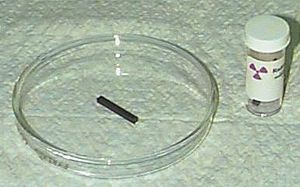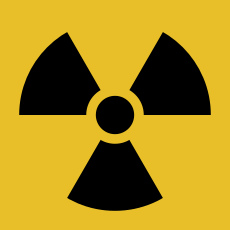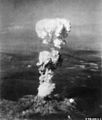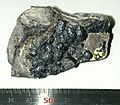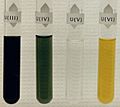Uranium facts for kids
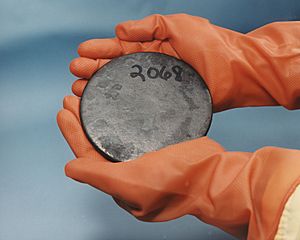 |
|||||||||||||||||||||||||||||||||||||||||||||||||||||
| Uranium | |||||||||||||||||||||||||||||||||||||||||||||||||||||
|---|---|---|---|---|---|---|---|---|---|---|---|---|---|---|---|---|---|---|---|---|---|---|---|---|---|---|---|---|---|---|---|---|---|---|---|---|---|---|---|---|---|---|---|---|---|---|---|---|---|---|---|---|---|
| Pronunciation | /jʊəˈreɪniəm/ |
||||||||||||||||||||||||||||||||||||||||||||||||||||
| Appearance | silvery gray metallic; corrodes to a spalling black oxide coat in air | ||||||||||||||||||||||||||||||||||||||||||||||||||||
| Standard atomic weight Ar, std(U) | 238.02891(3) | ||||||||||||||||||||||||||||||||||||||||||||||||||||
| Uranium in the periodic table | |||||||||||||||||||||||||||||||||||||||||||||||||||||
|
|||||||||||||||||||||||||||||||||||||||||||||||||||||
| Atomic number (Z) | 92 | ||||||||||||||||||||||||||||||||||||||||||||||||||||
| Group | n/a | ||||||||||||||||||||||||||||||||||||||||||||||||||||
| Period | period 7 | ||||||||||||||||||||||||||||||||||||||||||||||||||||
| Block | f | ||||||||||||||||||||||||||||||||||||||||||||||||||||
| Electron configuration | [Rn] 5f3 6d1 7s2 | ||||||||||||||||||||||||||||||||||||||||||||||||||||
| Electrons per shell | 2, 8, 18, 32, 21, 9, 2 | ||||||||||||||||||||||||||||||||||||||||||||||||||||
| Physical properties | |||||||||||||||||||||||||||||||||||||||||||||||||||||
| Phase at STP | solid | ||||||||||||||||||||||||||||||||||||||||||||||||||||
| Melting point | 1405.3 K (1132.2 °C, 2070 °F) | ||||||||||||||||||||||||||||||||||||||||||||||||||||
| Boiling point | 4404 K (4131 °C, 7468 °F) | ||||||||||||||||||||||||||||||||||||||||||||||||||||
| Density (near r.t.) | 19.1 g/cm3 | ||||||||||||||||||||||||||||||||||||||||||||||||||||
| when liquid (at m.p.) | 17.3 g/cm3 | ||||||||||||||||||||||||||||||||||||||||||||||||||||
| Heat of fusion | 9.14 kJ/mol | ||||||||||||||||||||||||||||||||||||||||||||||||||||
| Heat of vaporization | 417.1 kJ/mol | ||||||||||||||||||||||||||||||||||||||||||||||||||||
| Molar heat capacity | 27.665 J/(mol·K) | ||||||||||||||||||||||||||||||||||||||||||||||||||||
Vapor pressure
|
|||||||||||||||||||||||||||||||||||||||||||||||||||||
| Atomic properties | |||||||||||||||||||||||||||||||||||||||||||||||||||||
| Oxidation states | +1, +2, +3, +4, +5, +6 (a weakly basic oxide) | ||||||||||||||||||||||||||||||||||||||||||||||||||||
| Electronegativity | Pauling scale: 1.38 | ||||||||||||||||||||||||||||||||||||||||||||||||||||
| Ionization energies |
|
||||||||||||||||||||||||||||||||||||||||||||||||||||
| Atomic radius | empirical: 156 pm | ||||||||||||||||||||||||||||||||||||||||||||||||||||
| Covalent radius | 196±7 pm | ||||||||||||||||||||||||||||||||||||||||||||||||||||
| Van der Waals radius | 186 pm | ||||||||||||||||||||||||||||||||||||||||||||||||||||
| Spectral lines of uranium | |||||||||||||||||||||||||||||||||||||||||||||||||||||
| Other properties | |||||||||||||||||||||||||||||||||||||||||||||||||||||
| Natural occurrence | primordial | ||||||||||||||||||||||||||||||||||||||||||||||||||||
| Crystal structure | orthorhombic | ||||||||||||||||||||||||||||||||||||||||||||||||||||
| Speed of sound thin rod | 3155 m/s (at 20 °C) | ||||||||||||||||||||||||||||||||||||||||||||||||||||
| Thermal expansion | 13.9 µm/(m⋅K) (at 25 °C) | ||||||||||||||||||||||||||||||||||||||||||||||||||||
| Thermal conductivity | 27.5 W/(m⋅K) | ||||||||||||||||||||||||||||||||||||||||||||||||||||
| Electrical resistivity | 0.280 µΩ⋅m (at 0 °C) | ||||||||||||||||||||||||||||||||||||||||||||||||||||
| Magnetic ordering | paramagnetic | ||||||||||||||||||||||||||||||||||||||||||||||||||||
| Young's modulus | 208 GPa | ||||||||||||||||||||||||||||||||||||||||||||||||||||
| Shear modulus | 111 GPa | ||||||||||||||||||||||||||||||||||||||||||||||||||||
| Bulk modulus | 100 GPa | ||||||||||||||||||||||||||||||||||||||||||||||||||||
| Poisson ratio | 0.23 | ||||||||||||||||||||||||||||||||||||||||||||||||||||
| Vickers hardness | 1960–2500 MPa | ||||||||||||||||||||||||||||||||||||||||||||||||||||
| Brinell hardness | 2350–3850 MPa | ||||||||||||||||||||||||||||||||||||||||||||||||||||
| CAS Number | 7440-61-1 | ||||||||||||||||||||||||||||||||||||||||||||||||||||
| History | |||||||||||||||||||||||||||||||||||||||||||||||||||||
| Naming | after planet Uranus, itself named after Greek god of the sky Uranus | ||||||||||||||||||||||||||||||||||||||||||||||||||||
| Discovery | Martin Heinrich Klaproth (1789) | ||||||||||||||||||||||||||||||||||||||||||||||||||||
| First isolation | Eugène-Melchior Péligot (1841) | ||||||||||||||||||||||||||||||||||||||||||||||||||||
| Main isotopes of uranium | |||||||||||||||||||||||||||||||||||||||||||||||||||||
|
|||||||||||||||||||||||||||||||||||||||||||||||||||||
Uranium is a special metal found on the periodic table. It is a chemical element with an atomic number of 92. This means a uranium atom has 92 protons in its center, called the nucleus.
When uranium is dug from the ground, it comes in three main types called isotopes. These types have different numbers of neutrons in their nuclei. Most of it is Uranium-238. Uranium-235 is less common, and Uranium-234 is very rare. The main rock mined for uranium is called Pitchblende.
Uranium-235 is very important because it can be used in nuclear reactors and nuclear weapons. It works by creating a nuclear chain reaction. This process, called nuclear fission, splits the uranium-235 nucleus into two smaller nuclei. This creates lots of heat. This heat is useful for making steam in nuclear reactors to produce electricity. It can also cause big explosions in nuclear weapons. However, most nuclear weapons use Plutonium, which is made from Uranium-238.
Uranium is also a bit radioactive. This means it gives off energy that can be harmful.
Uranium that has had its Uranium-235 removed is called depleted uranium. It is used in special anti-tank weapons. Uranium was also once used as a dye for stained glass or pottery. People used it this way before they knew it was radioactive.
Uranium is a dangerous substance. Because it is radioactive, you often see it with the hazard sign for radioactive elements. This sign is a group of three triangles pointing inwards. Some movies show uranium as light green and glowing, but this is not true. Uranium is a shiny white metal. However, it is usually seen in its oxide form, which is black. Spent uranium fuel rods under water can glow blue due to Cherenkov radiation. Besides being radioactive, uranium is a heavy metal and can be toxic.
What is Uranium Like?
Uranium is a silvery-white metal that is slightly radioactive. It is quite hard, with a Mohs hardness of 6. It is malleable, meaning it can be shaped. It is also ductile, meaning it can be pulled into wires. Uranium is slightly paramagnetic and strongly electropositive. It does not conduct electricity very well. Uranium metal is very dense, weighing 19.1 grams per cubic centimeter.
Uranium metal reacts with almost all non-metal elements. Acids like hydrochloric and nitric acids can dissolve uranium.
Uranium-235 was the first isotope found to be fissile. This means its nucleus can be split easily. Other natural isotopes can also be split, but not as easily.
Only about 15 pounds (7 kg) of Uranium-235 can be used to make an atomic bomb. The atomic bomb dropped on Hiroshima, called Little Boy, used uranium fission.
How Uranium Was Discovered
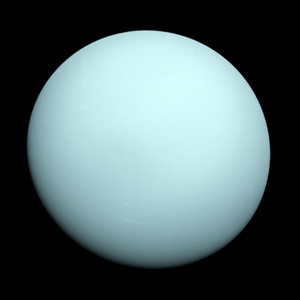
People used uranium in its natural oxide form as early as 79 CE. In the Roman Empire, it was used to make ceramic glazes yellow. Yellow glass with 1% uranium oxide was found in a Roman villa in Italy. This discovery was made in 1912 by R. T. Gunther.
In the late Middle Ages, pitchblende was dug up from silver mines in Joachimsthal, Bohemia (now in the Czech Republic). In the early 1800s, these mines were the only known places to find uranium ore.
| Periodic table | |||||||||||||||||||||||||||||||||||||||||
|---|---|---|---|---|---|---|---|---|---|---|---|---|---|---|---|---|---|---|---|---|---|---|---|---|---|---|---|---|---|---|---|---|---|---|---|---|---|---|---|---|---|
| H | He | ||||||||||||||||||||||||||||||||||||||||
| Li | Be | B | C | N | O | F | Ne | ||||||||||||||||||||||||||||||||||
| Na | Mg | Al | Si | P | S | Cl | Ar | ||||||||||||||||||||||||||||||||||
| K | Ca | Sc | Ti | V | Cr | Mn | Fe | Co | Ni | Cu | Zn | Ga | Ge | As | Se | Br | Kr | ||||||||||||||||||||||||
| Rb | Sr | Y | Zr | Nb | Mo | Tc | Ru | Rh | Pd | Ag | Cd | In | Sn | Sb | Te | I | Xe | ||||||||||||||||||||||||
| Cs | Ba | La | Ce | Pr | Nd | Pm | Sm | Eu | Gd | Tb | Dy | Ho | Er | Tm | Yb | Lu | Hf | Ta | W | Re | Os | Ir | Pt | Au | Hg | Tl | Pb | Bi | Po | At | Rn | ||||||||||
| Fr | Ra | Ac | Th | Pa | U | Np | Pu | Am | Cm | Bk | Cf | Es | Fm | Md | No | Lr | Rf | Db | Sg | Bh | Hs | Mt | Ds | Rg | Cn | Uut | Fl | Uup | Lv | Uus | Uuo | ||||||||||
|
|||||||||||||||||||||||||||||||||||||||||
Images for kids
-
Various militaries use depleted uranium as high-density penetrators.
-
The most visible civilian use of uranium is as the thermal power source used in nuclear power plants.
-
Uranium glass glowing under UV light
-
Uranium ceramic glaze glowing under UV light Design and developed by Dr. Sencer Sarı
-
Antoine Henri Becquerel discovered the phenomenon of radioactivity by exposing a photographic plate to uranium in 1896.
-
The mushroom cloud over Hiroshima after the dropping of the uranium-based atomic bomb nicknamed 'Little Boy'
-
Yellowcake is a concentrated mixture of uranium oxides that is further refined to extract pure uranium.
See also
 In Spanish: Uranio para niños
In Spanish: Uranio para niños




